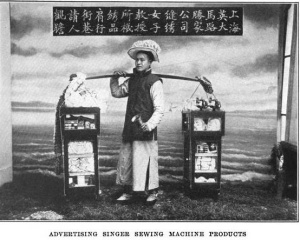Robert Standish’s Singapore Kate should have been titled Shanghai Kate. For much of the “action” takes place in Old Shanghai. Robert Standish aka Stephen Lister, both pseudonyms for writer Digby George Gerahty (1898 – 6 November 1981) introduces us to the exquisitely beautiful English girl, Kate Marlowe in Old Shanghai.
The Publisher’s note mentions how Kate Marlowe, an innocent young girl from Sussex faces a fighting battle against predators which as we find out later in the book include pimps, a brothel madam and always in pursuit wealthy Shanghai suitor keen on making her his mistress.
Robert Standish mentions he first met Kate Marlowe in Jessfield Park (Zhongshan park) in 1920 (though the book is published in 1919 or 1964…needs checking?) in Shanghai & was immediately smitten by her beauty. He later met her in Provencal, then Switzerland and after her death he inherited her Memory Box that could only be opened by pressing the tiger’s tail & putting a hand on the sage’s head. Much of what Standish wrote is based on the contents & clippings from Kate’s memory box.
The plot is fairly straightforward: Kate Wilder/Ferrari/Marlowe, leaves her unfaithful husband, Colin Wilder, is later (1903) employed by a dubious Madame Rosalie/Rosalie Jenkins selling high-fashion evening gowns from Paris & London to the westerners at Raffles Hotel, Singapore. The copper-haired beauty with blue-gray eyes attracts the attention of one John Ingleby of Ingleby & Waters, an old and established firm in Shanghai. The married John Ingleby tries his best to win her over, plots with Rosalie but finds Kate unimpressed. Instead, the engaging charms of the swashbuckling Gordon Maitland, a broker from Shanghai appeal to her much more.
Rosalie & Kate arrive in Shanghai from Hong Kong, ensconced in Kalee Hotel funded by mastermind Ingleby but unbeknownst to Kate. Kate and Gordon first meet at the lobby of Kalee Hotel where he jocularly calls her ‘Singapore Kate’ based on her luggage tag only having the label “Singapore.” But, Kate & Gordon’s early courtship comes to a twisted end with Ingleby sending Maitland to Hankow on a work errand. The ploy does not work and Kate finds out the truth & a distressed and alcoholic Madame Rosalie is soon found dead in Huangpu river. For failing Ingleby presumably….
Strapped for funds, Kate then moves to Broadway Hotel in HongKew (HongKou) run by Konstantin Pavelitch. Thereon, well-laid traps preying on Kate’s dwindling fortunes and innocence, the journey from prostitution to a madame of a brothel is marked with characters including Ingleby who died in her bed (not for the reason you are thinking of…tsk, tsk!), mountainous woman Belle Darling, Toni Simonides, a violent Greek cafe proprietor, Mary Simonides, a Cockney ex-dancer married to Toni, Edith Ingleby, all play a role in changing rather tarnishing Kate’s life forever.
The characters are so real, straight out of Old Shanghai’s badlands. The author’s note is what makes the story so very real.
I am reading another book though non-fiction on Shanghai prostitution and few characters described in this book & Singapore Kate bear quite a similarity. The timeline however needs checking.
So, was Kate a real person? Well, yes. Who was she? Was she Emily Moore? Who was Ingleby? There’s a brief mention of an Inspector from Shanghai Municipal Police who helps Kate successfully execute her revenge against those who pushed her into prostitution (a little too dramatic and seems contrived).
In the end, Kate leaves Shanghai forever auctioning her house (a brothel near Soochow/Suzhou creek) and its contents including 250 evening gowns, a magnificently carved ivory four-poster bed, linens, curtains and carpets….
“In every whore, Kate believed, there was a real need for respectability.” She left Shanghai as quietly as she had come. That need for anonymity and respectability was possible only after Kate made her money through prostitution.
While I felt huge amount of sympathy for Kate, the story harped many a times on her jaw-dropping beauty that seemed to strike men of all kinds.Could she not have taken up a teaching job or become an actress? As Kate points out that she could not become a governess because women mistrusted her and jobs for white women were very few. Plus, once she was in Belle’s brothel, it was not possible to come out with her reputation unscathed.
A very good read.








